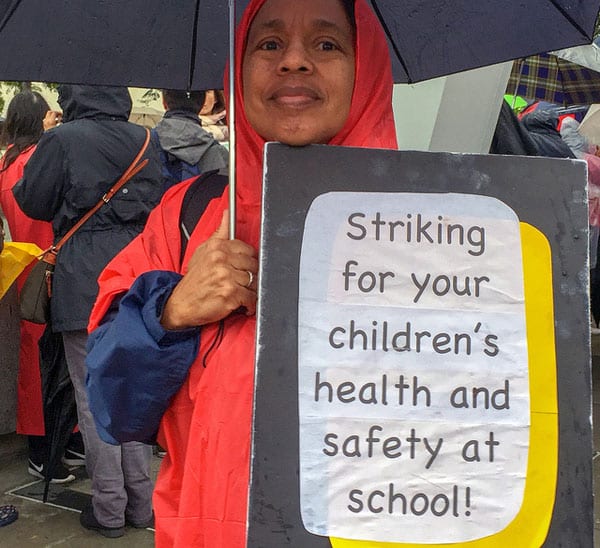
January 14, 2019; Truthout, Los Angeles Times, and Washington Post
For the first time in nearly 30 years, over 30,000 teachers, parents, administrators, and support staff from Los Angeles Unified School District (LAUSD), the nation’s second-largest public school district, went on strike yesterday. The strike comes after months of negotiations failed to achieve an agreement between LAUSD and United Teachers Los Angeles (UTLA), the teachers’ union. According to the UTLA site, their first proposal was offered in January 2017. Demands include:
- A 6.5 percent salary increase, retroactive to last year
- Increased funding for support staff such as librarians, counselors, and school nurses
- Smaller class sizes
- A moratorium on new charter schools
School superintendent Austin Beutner, a former investment banker, has taken a combative approach as he attempts to control the narrative over the strike.
“Show me the money, because we’re spending all we’ve got,” Beutner said. “If they want a strike, they’ll have a strike.” A statement from the District read, “A strike would harm the students and families we serve and will not help resolve the issues our District faces.” Beutner refused to even talk with UTLA regarding testing standards, calling the UTLA demands (since rescinded) “outside the scope of bargaining.” (We are then forced to ask, who defines the scope? Especially since involving teachers in decisions about testing isn’t likely to strain school budgets.). The union, for its part, says there is a budget surplus of over $1.8 billion held in reserves that could fund its demands.
But money isn’t the main matter in dispute, at least not directly. Rather, what led to the strike is the astonishing growth of charter schools. Charter schools, by reducing LAUSD enrollment, reduce taxpayer per-student payments to the district, thereby affecting finances. In the past decade, charters within the boundaries of LAUSD have grown by 287 percent. All told, about 100,000 students have migrated away from public schools in the past 10 years. The loss of enrollment, notes LAUSD high school journalism teacher Adriana Chavira, costs the district $600 million a year.
There is a temptation, perhaps, to view the strike through a standard management-labor lens, but that would be a mistake in this case. Philanthropy is involved, too!
These charters, after all, did not rise on their own; philanthropy played a major role. For example, back in 2015, NPQ noted that the Broad Foundation, led by Eli Broad (whose current net worth is estimated by Forbes to be $6.7 billion), had given $144 million to charter schools in Los Angeles and was promoting a plan to double the number of charters in eight years. Already, as of 2015, there were 207 privately-run, publicly funded charters that enrolled 16 percent of Los Angeles students. The new plan, as NPQ reported, promised $490 million in funding with the aim of adding another 260 charter schools and increasing charter enrollment by 130,000 students.
Sign up for our free newsletters
Subscribe to NPQ's newsletters to have our top stories delivered directly to your inbox.
By signing up, you agree to our privacy policy and terms of use, and to receive messages from NPQ and our partners.
There is more to this sordid tale. Some NPQ readers may recall that charter school proponents, with the backing of education philanthropy, won a majority on the LA Unified School board, only to find one of the people they helped elect, Ref Rodriguez, mired in a corruption scandal. Rodriguez ultimately pleaded guilty last July to a felony conspiracy charge and four misdemeanors for reimbursing donors to his 2015 election campaign and resigned his school board seat.
The stakes are large. Surely, it is not lost on anyone that if Broad’s vision of expanding charters by another 130,000 students were realized, LAUSD enrollment would fall by a like amount. That is why the union is demanding a moratorium on charter expansion.
Meanwhile, conditions at LAUSD have been allowed to deteriorate, with many schools overcrowded and underfunded. Makailah Jenkins, a junior at Washington Preparatory High, said she had to stand in one of her classes until a classmate transferred, freeing up a seat. Maria Arienza, a Spanish teacher at North Hollywood High, said her students sit on the floor because there aren’t enough desks.
Nearly 90 percent of LAUSD’s students are people of color, and about 75 percent qualify for free meals at school. That makes education funding an issue of racial and socioeconomic justice and an even more critical issue of public priorities. According to US News & World Report, California ranks #4 in the nation for higher education, which serves a much higher percentage of wealthier, white students, but #44 for pre-K-12 public education.
The strike, which is only the latest in a string of #RedForEd protests across the US, is supported by many in the community. Parents and students joined their teachers in protest on Monday. Local 99, the union of janitors, cafeteria workers, and other support staff, will join the strike for three days in 10 districts. Even some charter teachers in the district joined the strike, notably the Accelerated Schools network. Black Lives Matter at School wrote,
It is no coincidence that the cities and districts most targeted for divestment in public education and investment in privatization are communities with majority Black and Brown students and families. We urge all those involved in the Black Lives Matter at School movement to support the just demands of the UTLA community.
Advocates say they are striking for the very future of public education in Los Angeles, and this is a crucial moment. NPQ will follow the strike’s progress this week.—Erin Rubin











